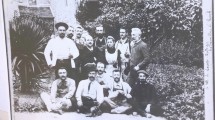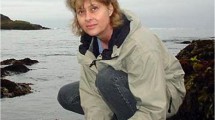Conclusion
The results of this study indicate that the reputation of W. K. Brooks was aided significantly by historical circumstances. The first of these factors was the unique historical role of Johns Hopkins University in American graduate education. The second was the impact of European experimentalism on American biologists and the consequent increase of experimentation in this country.
Johns Hopkins, as an institution, greatly aided in the selection, nurture, and placement of Brooks's students. To these institutional forces, Brooks did add direction toward marine biology and facilities for marine research. Also, his teaching methods—which were reinforced by his own natural quietness and his poor health—did encourage self-reliance: Brooks simply could not dominate over the day-to-day activities of his students.
The impact of European experimentalism was largely responsible for giving American biologists new approaches to problems which were beginning to assume major importance in biology. Several of Brooks's students, notably E. B. Wilson, T. H. Morgan, and Ross Harrison, were involved in this transfer of approaches and problems to America. In addition, a large number were influenced by working at the Marine Biological Laboratory at Woods Hole, where many of these new approaches were being used—in some cases for the first time, in this country. Both of these historical circumstances detract from Brooks's personal importance as an influential and directing force.
That Brooks allowed his students to pursue their own research with comparative freedom is indisputable. Perhaps this is the criterion for an outstanding teacher. But the fact remains that none of his best students followed Brooks's own line of investigation or his own method of research. It is less important here to evaluate Brooks as a teacher than to understand his influence on the direction of biological thought in the twentieth century. This study suggests that his influence was less important in terms of setting a direction for research than has previously been believed. What it is apparent that Brooks accomplished was the setting forth of biological topics in a larger context through his insistence on the relevance of philosophy to scientific research. How much this directly influenced his students, especially those outstanding individuals who later made important advances, is difficult to determine. This paper has tried to show that, in terms of available evidence, Brooks does not seem to have had the profound influence on early twentieth-century biology that some historians have claimed.
Similar content being viewed by others
References
E. A.Andrews, “William Keith Brooks,” Science, 28 (Dec. 4, 1908), 784.
Letter from J. Walter Wilson, Professor Emeritus of Biology at Brown University, Nov. 4, 1966.
E. G.Conklin, “William Keith Brooks,” Biographical Memoirs of the National Academy of Sciences (hereafter, NAS), 7 (1913), 38.
G. Lefevre, in “William Keith Brooks Memorial Volume,” J. Exp. Zool., 9 (1910), 15.
E. A. Andrews to E. G. Conklin, Nov. 9, 1909. In the Edwin Grant Conklin Papers (Firestone Library, Princeton University). Hereafter referred to as Conklin Papers.
Lefevre, J. Exp. Zool., p. 16.
W. R.Coe, “A Century of Zoology in America,” in A Century of Science in America (New Haven: Yale University Press, 1918), pp. 391–438.
W. W. Willoughby, “The History of Summer Schools in America,” Report of the Commission of Education for the Year 1891–1892, 2, 953.
Anonymous, Penikese: A Reminiscence by One of Its Pupils (Albion, New York: Frank H. Lattin, 1895), pp. 39–45.
L.Cooper, Louis Agassiz as a Teacher (Ithaca, New York: Comstock Publishing Company, 1945), pp. 32–33.
Johns Hopkins University Circulars (hereafter Circulars), Original Series, No. 9 (1879), p. 111.
Johns Hopkins University Inaugural Addresses, 1876 (Baltimore: John Murphy and Company, 1876), p. 38.
Ithaca, New York: Cornell University Press, 1960.
W. C. Ryan, Studies in Early Graduate Education: The Johns Hopkins, Clark University, the University of Chicago (Carnegie Foundation for the Advancement of Teaching, Bulletin No. 30, New York, 1939), p. 32.
D. C. Gilman to H. N. Martin, March 14, 1876, Gilman Papers, Eisenhower Library, Johns Hopkins University.
H. N. Martin to D. C. Gilman, May 29, 1876, Gilman Papers.
“The Study and Teaching of Biology,” Pop. Sci. Monthly, 10, 300.
Ibid., pp. 308–309.
Circulars, Original Series, No. 7 (1877), pp. 66–67.
W. K. Brooks to A. Agassiz, Oct. 26, 1876, Agassiz Papers, Library of the Museum of Comparative Zoology, Harvard University.
W. K. Brooks to W. Faxon, n.d., Agassiz Papers.
E. G. Conklin, “Address at the Jubilee of the Department of Biology at Western Reserve University, Dec. 3, 1938,” “(MS),” Conklin Papers.
Circulars, No. 30 (April 1884), p. 87.
Agassiz's work was a very small-scale continuation of the Anderson School. Baird's was devoted primarily to research on the economic aspects of fish breeding habits, etc.
Circulars, N. S. No. 1, p. 24.
Report of the President of Johns Hopkins University, 1878, p. 50.
Ibid., p. 52.
Circulars, No. 30 (April 1884), p. 91.
Ibid., p. 93.
Ibid., No. 9 (March 1881), p. 112.
W. K. Brooks to W. Faxon, Dec. 15, 1880, Agassiz Papers.
Circulars, No. 30 (April 1884), p. 93.
Ibid., No. 54 (Dec. 1886), pp. 40–41. Included in the morphological category are the results of a dozen or so embryological investigations. These two areas were closely allied at this time.
Ibid., p. 37.
E. B. Wilson to D. C. Gilman, July 11, 1880, Gilman Papers.
Conklin, “Address ... at Western Reserve University ...” “(MS),” pp. 12–13.
W. K. Brooks to D. C. Gilman, May 29, 1887, Gilman Papers.
Circulars, No. 95 (February 1892), p. 45.
Ibid., No. 97 (April 1892), pp. 65–85.
W. K. Brooks to D. C. Gilman, June 2, 1897, Gilman Papers. During the years 1887 to 1896, Hopkins sent at least one man to this station each summer.
Conklin, NAS, 7, 52.
Ibid., pp. 79–88.
W. R.Coe, “A Century of Zoology in America.” Also see: F. R. Lillie, The Woods Hole Marine Biological Laboratory (Chicago: University of Chicago Press, 1944), p. 117; E. B. Wilson, “Aims and Methods of Study in Natural History,” Science, 13 (January 1901), 14–23; and E. G. Conklin, “The Marine Biological Laboratory,” Science, 11 (March 1900), 333–344.
C. S.Minot, “The Work of the Naturalist in the World,” Pop Sci. Monthly, 47 (1895), 60–72.
W. K.Brooks, “Joseph Leidy,” Anat. Record, 1 (June 1907), 111.
Biological Science, 22 (December 1951), 239.
Cooper, Agassiz, p. 42.
Circulars, N. S. No. 1 (1909), p. 12.
Lefevre, J. Exp. Zool., pp. 13–14.
Wilson, J. Exp. Zool., p. 9, and Conklin, “The Life and Work of William Keith Brooks,” Anat. Record, 3 (January 1909), 6.
Bigelow, “Memoir—W. K. Brooks,” Proceedings of the American Academy of Arts and Science, 71 (March 1937), 491 and Howell, Circulars, N. S. No. 1 (1909), p. 12.
NAS, 7, 44.
“Brooks,” J. Exp. Zool., 9, 10–11.
T. H. Morgan, “Edmund Beecher Wilson,” NAS, 20 (1939); E. G. Conklin, “Thomas Hunt Morgan,” Biol. Bull., 93 (August 1947), 14–18.
Wilson, quoted in T. H. Morgan, NAS, 20, 319; Conklin, Anat. Record, 3, 9.
Circulars, N. S. No. 1 (1909).
W. K.Brooks, The Foundations of Zoology (New York: MacMillan, 1899), p. 3.
Smithsonian Institute Annual Report—1900 (Washington, D. C.: U. S. Government Printing Office, 1902), p. 710.
Morgan, NAS, 20, 319; A. H.Sturtevant, “Thomas Hunt Morgan,” NAS, 31 (1958), 284; J. S. Nicholas, “Ross Granville Harrison,” NAS, 35 (1961), 134.
Bateson was at the CZL for the entire summer of 1884, but Brooks became ill and had to leave after one month. H. W. Conn to D. C. Gilman, July 3, 1884; July 26, 1884; August 18, 1884. Gilman Papers.
Bateson, J. Exp. Zool., 9, 7.
Quoted in Morgan, NAS, 20, 319.
Ibid., pp. 320–321.
Sturtevant, NAS, 31, 284.
Ibid., p. 285.
Ibid., p. 287.
Conklin, Biol. Bull., p. 16.
E. B. Wilson's references to Brooks are also infrequent and his references to Dohrn frequent. In the Conklin Papers there are hundreds of letters to Conklin from Wilson and Morgan. These letters also follow suit—a number of references to Dohrn, absolutely none to Brooks.
Circulars, 1888–1891.
E. N.Harvey, “Edwin Grant Conklin,” NAS, 31 (1957), 63.
E. N.Harvey, “Edwin Grant Conklin,” NAS, 31 (1957), pp. 63–64.
Nicholas, NAS, 35, pp. 134–135.
Ibid., p. 135.
Essays in the History of Embryology and Biology (Cambridge, Mass.: MIT Press, 1967), pp. 93–94.
Nicholas, NAS, 35, 137.
Science, 13, 16.
Author information
Authors and Affiliations
Rights and permissions
About this article
Cite this article
McCullough, D.M. W. K. Brooks's role in the history of American biology. J Hist Biol 2, 411–438 (1969). https://doi.org/10.1007/BF00125026
Issue Date:
DOI: https://doi.org/10.1007/BF00125026




